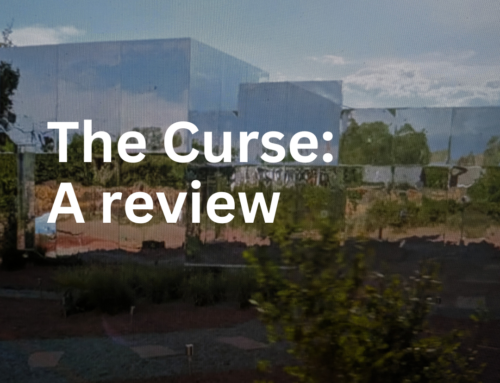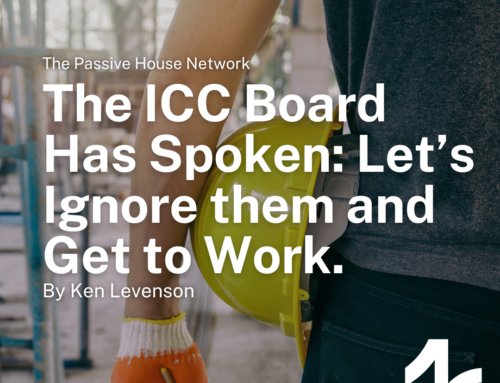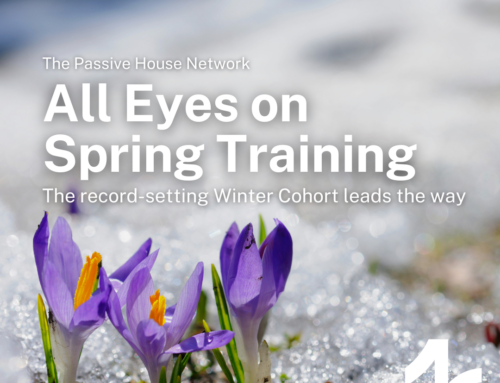Passive House Open Days Nov 6 – 8:
In honor of these International Passive House Open Days, NAPHN is making publicly available, November 6-8, a select few presentations that speak from an owner’s perspective, and all the building tour videos, from our conference, Passive House 2020.
And if that wasn’t enough, we’re also including the Owner’s Manual and the (3) eBooks that accompany the Owners Roundtable sessions. …Never too much Passive House.
(NOTE: LINKS WILL GO LIVE NOVEMBER 6 & GO DEAD AT END OF NOVEMBER 8.)
Enjoy!
OWNERS ROUNDTABLE VIDEOS
So to get started, first up are three fascinating owner roundtable discussions:
Owners Roundtable #1: Deciding to Do It: How Owners Choose Passive House
How will you make a “go/no go” decision to pursue the Passive House Standard? How is certification described and related to developing team clarity and decision making? What’s the role of new regulations, financing opportunities, market differentiation, and risk assessment? Is Passive House Certification the goal or a means to a greater end? Building developers lay out their criteria and process, in a peer discussion you can participate in.
Owners Roundtable #2: How Owners’ Do it. Making Passive House Good Business
Going forward, how will the Passive House methodology fit into your typical project delivery and business mechanics? Two developers will describe the project delivery decisions made to meet their project and business requirements, including financing, team building, planning, and execution, in a peer discussion you can participate in.
Owners Roundtable #3: Owners’ Feedback Loop: Occupancy, Measurement, and Management
Now that you own a completed Passive House building, how will you drive it? Manual or smart data collection and feedback? Occupant education? Systems calibrations and maintenance? Building owners, in peer discussion you can participate in, tell how they are running their buildings to maintain long-term high-performance.
15 BUILDING TOURS:
Yes, 15 building tours. We had shown 7 on July 1, and another 8, on July 15.
- AB Passive House Plus, Masonville, CO
- Morgan Avenue Retrofit, Bronx, NY
- Star Garment Innovation Center, Sri Lanka
- 2Good Energy Haus, Minneapolis, MN
- Hermit Hut, San Francisco Bay Area, CA
- Private House Los Angeles (PHLA+), Los Angeles, CA
- Passive House Museum, China
- Whistler Housing Authority Multifamily, Whistler, CA
- Clayton Community Centre, Surrey, BC
- Superhouse, Honeoye Falls, NY
- Olive House, Hudson Valley, NY
- Sawkill EnerPHit, Brooklyn, NY
- FlowChelsea, Multifamily High-Rise, New York, NY
- Brownstone Retrofit, Brooklyn, NY
- National Residence Center, China
WAIT, THERE’S MORE!
(Each with voice of ownership.)
Historic Preservation, Use Conversion & Affordable Development: An EnerPHit Story
A historic masonry high school building is being converted into senior housing. With funding from the Connecticut Housing Finance Authority, approvals are required not just to meet the EnerPHit Passive House Institute renovation standard, but also to satisfy the State Historic Preservation Office and the National Park Service. Learn from team leaders the strategies, the planning and design hurdles, and construction milestones to date, and their path forward to achieve their comprehensive goals.
Keep Your Students Healthy & Funders Happy: Passive House Matriculates
As the Education sector tackles climate change on their campuses, there is no question that student residences and dormitories should be designed to meet Passive House standards. Why? Not only will the building reduce net energy use by 60% and -become more resilient, but the resultant healthy interior environment will improve the wellness of the occupant. Embracing this high-performance design protocol for student residences of any size will align three goals for any campus: sustainability, student health, and bottom-line financial performance. This presentation will demonstrate how these goals can be achieved. Featured case studies are The House at Cornell Tech, the world’s largest Passive House university building, and the new 750 bed dormitory at the University of Toronto Scarborough, each of which is setting a new bar for performance and healthy living.
Retrofit Everything: Scaling Action in New York and Ontario
Governments are acting to scale building retrofits as a core climate crisis solution, and in the process transform dynamics and expectations across the entire building industry. NYSERDA is entering the next phase of RetrofitNY, a program focused on multifamily upgrades, now including New York City Housing Authority (NYCHA) buildings. Toronto Community Housing is embarking on a multiyear effort to upgrade its stock of 2,100+ buildings. Discuss with the presenters, how they are utilizing Passive House and the EnerPHit renovation standard, to transform industry in New York, and Ontario, and how it can support your plans.
New York City Public Schools: An Education in Passive House Performance
NYC owns a lot of buildings and city regulations, since 2016, require that newly built city-owned buildings achieve Passive House levels of efficiency by 2030. The City School Construction Authority (SCA) builds twenty new schools per year or about 1.5 million square feet, and has turned to Passive House to help shape this future. Presenters will answer questions such as: How are they complying? What are the major energy reduction strategies? Modeling methods? What are the decision making factors, including cost, constructability, and maintenance? What are the final recommendations?
We hope you’re having a great International Passive House Open Days event!




